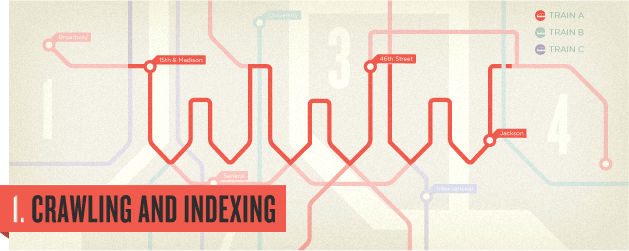
HOW SEARCH ENGINES OPERATE
Search engines have two major functions: crawling and building an index, and providing search users with a ranked list of the websites they've determined are the most relevant.

Each stop is a unique document (usually a web page, but sometimes a PDF, JPG, or other files). The search engines need a way to “crawl” the entire city and find all the stops along the way, so they use the best path available—links.
Crawling and indexing the billions of documents, pages, files, news, videos, and media on the World Wide Web. Providing
Providing answers to user queries, most frequently through lists of relevant pages that they've retrieved and ranked for relevancy.
Links allow the search engines' automated robots, called "crawlers" or "spiders," to reach the many billions of interconnected documents on the web.
 Once the engines find these pages, they decipher the code from them and store selected pieces in massive databases, to be recalled later when needed for a search query. To accomplish the monumental task of holding billions of pages that can be accessed in a fraction of a second, the search engine companies have constructed datacenters all over the world.
Once the engines find these pages, they decipher the code from them and store selected pieces in massive databases, to be recalled later when needed for a search query. To accomplish the monumental task of holding billions of pages that can be accessed in a fraction of a second, the search engine companies have constructed datacenters all over the world.
These monstrous storage facilities hold thousands of machines processing large quantities of information very quickly. When a person performs a search at any of the major engines, they demand results instantaneously; even a one- or two-second delay can cause dissatisfaction, so the engines work hard to provide answers as fast as possible.

Search engines are answer machines. When a person performs an online search, the search engine scours its corpus of billions of documents and does two things: first, it returns only those results that are relevant or useful to the searcher's query; second, it ranks those results according to the popularity of the websites serving the information. It is both relevance and popularity that the process of SEO is meant to influence.
To a search engine, relevance means more than finding a page with the right words. In the early days of the web, search engines didn’t go much further than this simplistic step, and search results were of limited value. Over the years, smart engineers have devised better ways to match results to searchers’ queries. Today, hundreds of factors influence relevance, and we’ll discuss the most important of these in this guide.
 Search engines typically assume that the more popular a site, page, or document, the more valuable the information it contains must be. This assumption has proven fairly successful in terms of user satisfaction with search results.
Search engines typically assume that the more popular a site, page, or document, the more valuable the information it contains must be. This assumption has proven fairly successful in terms of user satisfaction with search results.
Popularity and relevance aren’t determined manually. Instead, the engines employ mathematical equations (algorithms) to sort the wheat from the chaff (relevance), and then to rank the wheat in order of quality (popularity).
These algorithms often comprise hundreds of variables. In the search marketing field, we refer to them as “ranking factors.” Moz crafted a resource specifically on this subject: Search Engine Ranking Factors.
 The complicated algorithms of search engines may seem impenetrable. Indeed, the engines themselves provide little insight into how to achieve better results or garner more traffic. They do provide us with Knowlege concerning optimization and best practices is described below:
The complicated algorithms of search engines may seem impenetrable. Indeed, the engines themselves provide little insight into how to achieve better results or garner more traffic. They do provide us with Knowlege concerning optimization and best practices is described below:
Google recommends the following to get better rankings in their search engine:
 Make pages primarily for users, not for search engines. Don't deceive your users or present different content to search engines than you display to users, a practice commonly referred to as "cloaking."
Make pages primarily for users, not for search engines. Don't deceive your users or present different content to search engines than you display to users, a practice commonly referred to as "cloaking."
Bing engineers at Microsoft recommend the following to get better rankings in their search engine:
 Ensure a clean, keyword rich URL structure is in place.
Ensure a clean, keyword rich URL structure is in place.

In addition to this freely-given advice, over the 15+ years, that web search has existed, search marketers have found methods to extract information about how the search engines rank pages. SEOs and marketers use that data to help their sites and their clients achieve better positioning.
Surprisingly, the engines support many of these efforts, though the public visibility is frequently low. Conferences on search marketing, such as the Search Marketing Expo, Pubcon, Search Engine Strategies, Distilled, and Moz’s own MozCon attract engineers and representatives from all of the major engines. Search representatives also assist webmasters by occasionally participating online in blogs, forums, and groups.

There is perhaps no greater tool available to webmasters researching the activities of the engines than the freedom to use the search engines themselves to perform experiments, test hypotheses, and form opinions. It is through this iterative—sometimes painstaking—process that a considerable amount of knowledge about the functions of the engines has been gleaned. Some of the experiments we’ve tried go something like this:
In our test, we started with the hypothesis that a link earlier (higher up) on a page carries more weight than a link lower down on the page. We tested this by creating a nonsense domain with a home page with links to three remote pages that all have the same nonsense word appearing exactly once on the page. After the search engines crawled the pages, we found that the page with the earliest link on the home page ranked first.
In addition to this kind of testing, search marketers can also glean competitive intelligence about how the search engines work through patent applications made by the major engines to the United States Patent Office. Perhaps the most famous among these is the system that gave rise to Google in the Stanford dormitories during the late 1990s, PageRank, documented as Patent #6285999: "Method for node ranking in a linked database." The original paper on the subject – Anatomy of a Large-Scale Hypertextual Web Search Engine – has also been the subject of considerable study. But don't worry; you don't have to go back and take remedial calculus in order to practice SEO!
Through methods like patent analysis, experiments, and live testing, search marketers as a community has come to understand many of the basic operations of search engines and the critical components of creating websites and pages that earn high rankings and significant traffic.
Chuck Reynolds
Contributor
